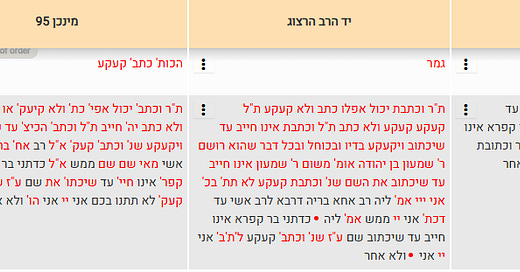A Missing Brayta about Tattoos
On Makkot 21a, the Mishnah is followed immediately by an Amoraic statement.
מַתְנִי׳ הַכּוֹתֵב כְּתוֹבֶת קַעֲקַע. כָּתַב וְלֹא קִעֲקַע, קִעֲקַע וְלֹא כָּתַב – אֵינוֹ חַיָּיב, עַד שֶׁיִּכְתּוֹב וִיקַעְקַע (בְּיָדוֹ) [בִּדְיוֹ] וּבִכְחוֹל וּבְכׇל דָּבָר שֶׁהוּא רוֹשֵׁם. רַבִּי שִׁמְעוֹן בֶּן יְהוּדָה מִשּׁוּם רַבִּי שִׁמְעוֹן אוֹמֵר: אֵינוֹ חַיָּיב עַד שֶׁיִּכְתּוֹב שֵׁם אֶת הַשֵּׁם, שֶׁנֶּאֱמַר: ״וּכְתֹבֶת קַעֲקַע לֹא תִתְּנוּ בָּכֶם אֲנִי ה׳״.
MISHNA: One who imprints a tattoo, by inserting a dye into recesses carved in the skin, is also liable to receive lashes. If one imprinted on the skin with a dye but did not carve the skin, or if one carved the skin but did not imprint the tattoo by adding a dye, he is not liable; he is not liable until he imprints and carves the skin, with ink, or with kohl [keḥol], or with any substance that marks. Rabbi Shimon ben Yehuda says in the name of Rabbi Shimon: He is liable only if he writes the name there, as it is stated: “And a tattoo inscription you shall not place upon you, I am the Lord” (Leviticus 19:28).
גְּמָ׳ אֲמַר לֵיהּ רַב אַחָא בְּרֵיהּ דְּרָבָא לְרַב אָשֵׁי: עַד דְּיִכְתּוֹב
GEMARA: Rav Aḥa, son of Rava, said to Rav Ashi: Is Rabbi Shimon saying that one is liable only if he actually inscribes the words
However, this is because the printed texts (Venice and then Vilna) skipped over an entire brayta. The two manuscripts have an intervening Teno Rabbanan brayta.
as does the CUL: T-S F 1(1).26 fragment. Here is an image from Yad HaRav Herzog.
Looking only at the Yad HaRav Herzog manuscript, I would guess that what happened That is, the brayta ends similarly to the Mishnah, and has the same players, so a scribe could accidentally skip right over it. Here is the text and my own translation.
ת"ר וכתבת יכול אפלו כתב ולא קעקע ת"ל קעקע קעקע ולא כתב ת"ל וכתבת אינו חייב עד שיכתוב ויקעקע בדיו ובכוחל ובכל דבר שהוא רושם ר' שמעון בן יהודה אומ' משום ר' שמעון אינו חייב עד שיכתוב את השם שנ' וכתבת קעקע לא תת' בכ' אני ייי
The Sages taught in a brayta: (Leviticus 19:28) וּכְתֹ֣בֶת / “and an inscription”. One might think even if he wrote and didn’t incise; therefore it teaches קַֽעֲקַ֔ע / “incision”. If he incised and did not inscribe, therefore it teaches וּכְתֹ֣בֶת / “and an inscription”. Thus, he is not liable until he inscribes and incises — with ink, kohl, or anything which makes a mark. Rabbi Shimon ben Yehuda says: He is liable only if he writes the name there, as it is stated: “And a tattoo inscription you shall not place upon you, I am the Lord” (Leviticus 19:28).
However, I don’t think that is entirely what happened. Rather, there is also dittography in play. What I put in italics above does not seem like part of the brayta. Here is the much shorter text of the Munich 95 manuscript along with my translation. This is the brayta that then leads directly into Rav Acha b. Rava’s question to Rav Ashi:
ת"ר וכתב' יכול אפי' כת' ולא קיעק' או קיעקע ולא כתב יה' חייב ת"ל וכתב' הכיצ' עד שיכתו' ויקעקע שנ' וכתב' קעק'
The Sages taught in a brayta: One might have thought that even if he wrote and didn’t incise, or incised but did not write, that he would be liable. Therefore it teaches וּכְתֹ֣בֶת. How so? Until he writes and incises, as it is written וּכְתֹבֶת קַעֲקַע.
That version of the brayta strikes me as a bit to short — the style is choppy, and the prooftext is only one word, not the other. But the middle ground would be the brayta as it begins in Yad Harav Herzog, that is:
ת"ר וכתבת יכול אפלו כתב ולא קעקע ת"ל קעקע קעקע ולא כתב ת"ל וכתבת אינו חייב עד שיכתוב ויקעקע
The Sages taught in a brayta: (Leviticus 19:28) וּכְתֹ֣בֶת / “and an inscription”. One might think even if he wrote and didn’t incise; therefore it teaches קַֽעֲקַ֔ע / “incision”. If he incised and did not inscribe, therefore it teaches וּכְתֹ֣בֶת / “and an inscription”. Thus, he is not liable until he inscribes and incises
So my inclination is that this is the original brayta. But then, dittography kicked it. The phrase אֵינוֹ חַיָּיב עַד שֶׁיִּכְתּוֹב וִיקַעְקַע also appears in the Mishnah. So then, some scribe copied that ending in. But then, since that transformed the brayta into something with lots of overlap with the Mishnah, another step of haplography kicked in.






